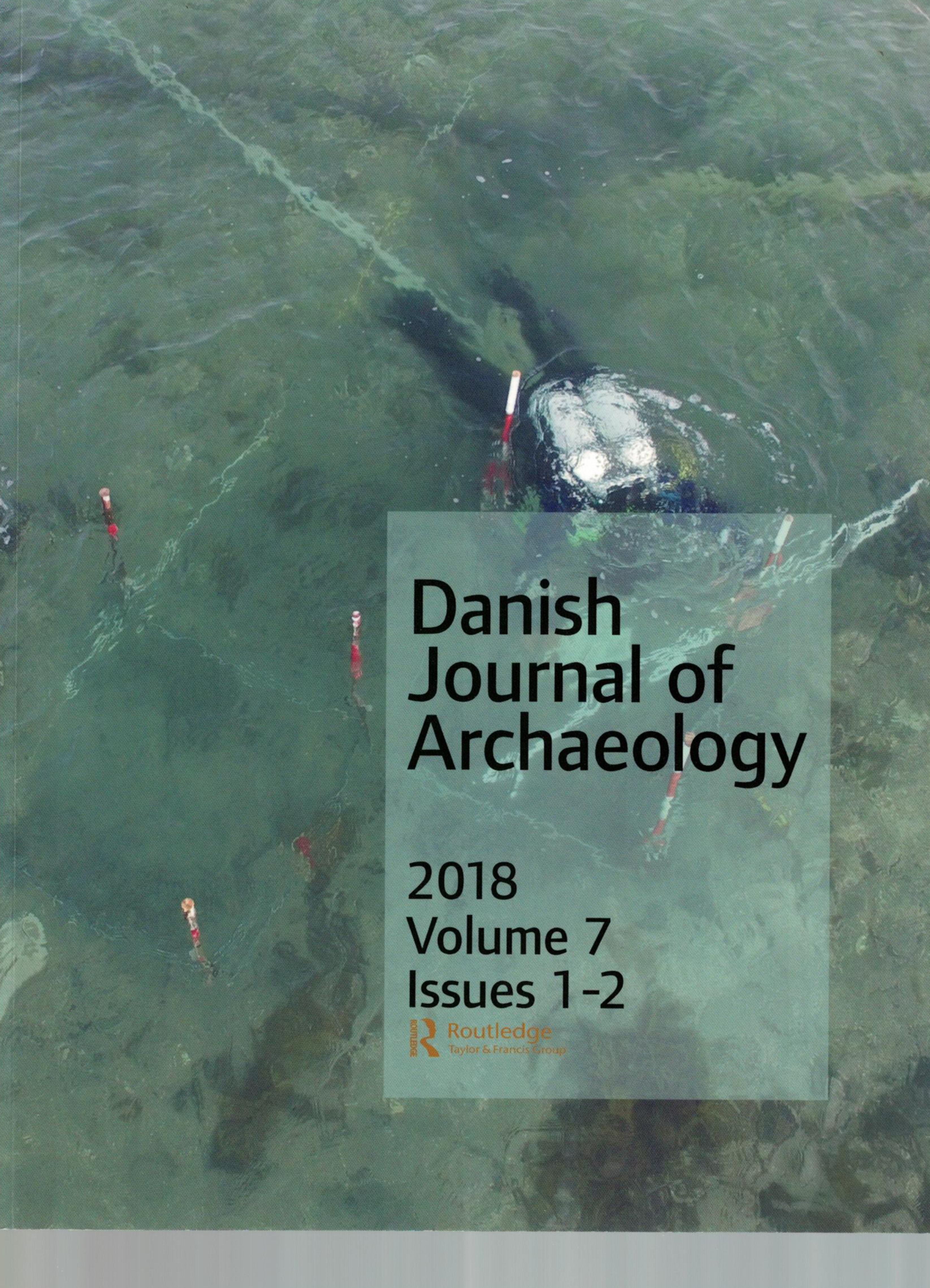Failing arguments for the presence of iron in Denmark during the Bronze Age Period IV.
Regarding the razors from Kjeldbymagle and Arnitlund and a knife from Grødby
DOI:
https://doi.org/10.7146/dja.v7i0.124809Keywords:
Early iron age;, introduction of iron, iron;Abstract
The dark squiggly lines of the razors from Kjeldbymagle and Arnitlund are often mentioned, along with the knife from Grødby, as the earliest examples of iron in Denmark. The razors can be dated to the early Late Bronze Age (Period IV) – around 1000 BC – due to their form and ornamentation, while the iron knife from Grødby is reported to have been found in a slightly earlier urn burial.
Recent metallurgical analyses have, however, shown that the squiggly lines are not in fact iron, but rather copper covered by a layer of iron-bearing corrosion, and that the knife’s context with the other grave objects must be considered uncertain. This means that there is no evidence for the presence of iron in Denmark until the very end of the Bronze Age – around 700–500 BC.
References
Baudou, E., 1960. Die regionale und chronologische Einteilung der jüngeren Bronzezeit im Nordischen Kreis. Acta Universitatis Stockholmiensis. Studies in North-European Archaeology 1. Stockholm.
Berger, D., 2012. Bronzezeitliche Färbetechniken an Metallobjekten nördlich der Alpen. Eine archäometallurgische Studie zur prähistorischen Anwendung von Tauschierung und Patinierung anhand von Artefakten und Experimenten. Forschungsberichte des Landesmuseums für Vorgeschichte Halle 2. Halle (Saale).
Berger, D. 2014. Late Bronze Age iron inlays on bronze artefacts in central Europe. In: E. Pernicka and R. Schwab (Hrsg.) Under the volcano. Proceedings of the International Symposium of the Metallurgy of the European Iron Age in Mannheim 2010, Forschungen zur Archäometrie und Altertumswissenschaft 5. Rahden/Westfahlen. 9–24.
Boye, V., 1858. Begravelser fra Steen- og Broncealderen, undersögte og beskrevne af V. Boye. Annaler for nordisk Oldkyndighed og Historie 1858. Kjöbenhavn, 200–215.
Broholm, H.C., 1933. Studier over den yngre Bronzealder i Danmark med særligt Henblik paa Gravfundene. København: Aarbøger for nordisk Oldkyndighed og Historie 1933, 1–351.
Buchwald, V.F., 2008. Iron, steel and cast iron before Bessemer. Historisk-filofiske Skrifter 32. The Royal Danish Academy of Sciences and Letters. København.
Fabech, E.W. 1979. Konserveringsberetning 19. 2.79. Nationalmuseet. København. Unpublished.
Hedeager, L. 1988. Danernes Land. Gyldendals og Politikens Danmarkshistorie. Bind 2. København.
Hedeager, L. 1988. Danernes Land. Gyldendals og Politikens Danmarkshistorie. Bind 2. København.
Hornstrup, K.M., et al., 2005. Hellegård – en gravplads fra omkring år 500 f.Kr. Aarbøger for Nordisk Oldkyndighed Og Historie, 2002, 83–162.
Jensen, C.K., 2005. Kontekstuel kronologi – en revision af det kronologiske grundlag for førromersk jernalder i Sydskandinavien. Bind 1-2. LAG 7. Moesgård. Århus: Afdeling for forhistorisk arkæologi.
Jensen, J., 1997. Fra Bronze- til Jernalder – en kronologisk undersøgelse. Nordiske fortidsminder serie B, bind 15. København: Det kongelige nordiske Oldskriftselskab.
Jouttijärvi, A., 1996. Jern i den sønderjyske jernalder. Neumünster: Arkæologi i Slesvig - Archäologie in Schleswig 11, 27–32.
Kaul, F., Jernalderen i Den Store Danske, Gyldendal. Hentet fra http://denstoredanske.dk/index.php?sideId=101227 Accessed 26 oktober 2017.
Kaul, F., 1998. Ships on Bronzes. A Study in Bronze age religion and iconography. Studies in Archaeology & History, 3, 1–2. Publicationsfrom the National Museum. København.
Kimmig, W., 1964. Seevölkerbewegung und Urnenfelderkultur. In: Teil I, R. von Uslar and K. Narr (Hrsg). Studien aus Alteuropa. Kurt Tackenberg gewidmet. Köln, 220–283.
Levinsen, K., 1984. Jernets introduktion i Danmark. Kuml, 1982–83 (Viborg), 153–168.
Lyngstrøm, H., 2008. Dansk Jern – en kulturhistorisk analyse af fremstilling, fordeling og forbrug. København: Nordiske Fortidsminder serie C, bind 5.
Lyngstrøm, H., 2016. Sjællandsk jernforskning og en tur blandt jernalderens skovbønder i.Nordøstsjælland. I: Mellan slott och slagg. Vänbok till Anders Ödman. Red: Gustin, I., M. Hansson, M. Roslund & J. Wienberg. Lund Studies in Historical Archaeology 17. Lund. 139-144.
Meller, H., 2002. Die Himmelscheibe von Nebra – ein frühbronzezeitlicher Fund von außergewöhnlicher Bedeutung. Archäologie in Sachsen-Anhalt, 1, 7–20.
Müller, S., 1914. Sønderjyllands Bronzealder. Aarbøger for nordisk Oldkyndighed og Historie 1914. København, 195–348.
Nørbach, L.C., 1998. Ironworking in Denmark. from the late bronze age to the early roman iron age. København: Acta Archaeologica 69, 53–75.
Olesen, M.W., 2010. Hvornår starter dansk jernudvinding? Museum Midtjylland – Midtjyske Fortællinger, 2010 (Herning), 83–92.
Pleiner, R., 2000. Iron in Archaeology. The European Bloomery Smelters. Prag.
Randsborg, K., 1972. From Period III to period IV. Chronological studies and the Bronze Age in Southern Scandinavia and Northern Germany. Publications of the National Museum Archaeological-Historical Series I, vol. XV. København.
Rundberget, B., Larsen, J.H., and Haraldsen, T.H.B. (red.) 2013. Ovnstypologi og ovnskronologi i den nordiske jernvinna. Jernvinna i Oppland. Symposium på Kittilbu, 16.- 18. Accessed Jun 2009. Oslo. https://doi.org/10.23865/noasp.57
Schwab, R., Ullén, I., and Wunderlich, C.-H., 2010. A sword from Vreta Kloster, and black patinated bronze in Early Bronze Age Europe. Journal of Nordic Archaeological Science, Jonas 17. The Archaeological Research Laboratory. Stockholm. 27–35.
Thrane, H., 2004. Fyns Yngre Broncealdergrave. Bind 1 og 2. Odense.
Vedel, E., 1886. Bornholms Oldtidsminder og Oldsager. København.
Downloads
Published
How to Cite
Issue
Section
License
Counting from volume 11 (2022), articles published in DJA are licensed under Attribution-NonCommercial-ShareAlike 4.0 International (CC BY-NC-SA 4.0). The editorial board may accept other Creative Commons licenses for individual articles, if required by funding bodies e.g. the European Research Council. With the publication of volume 11, authors retain copyright to their articles and give DJA the right to the first publication. The authors retain copyright to earlier versions of the articles, such as the submitted and the accepted manuscript.
Articles in volume 1-8 are not licensed under Creative Commons. In these volumes, all rights are reserved to DJA. This implies that readers can download, read, and link to the articles, but they cannot republish the articles. Authors can upload their articles in an institutional repository as a part of a green open access policy.
Articles in volume 9-10 are not licensed under Creative Commons. In these volumes, all rights are reserved to the authors of the articles respectively. This implies that readers can download, read, and link to the articles, but they cannot republish the articles. Authors can upload their articles in an institutional repository.





